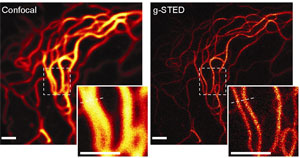
Leica Signs Gated STED Development Deal
WETZLAR, Germany, Nov. 16, 2011 — Leica Microsystems signed an agreement with the Max Planck Society and the German Cancer Research Center (DKFZ) to develop gated stimulated emission depletion (STED) microscopy, the next generation of the superresolution technique. Under the contract, Leica Microsystems is licensed to commercialize and market the new technology.

Gated STED nanoscopy provides fundamentally improved spatial resolution over confocal microscopy in living cells. Here, the protein keratin is marked with the fluorescent protein Citrine in a living PtK2 cell. The insets show a magnified view of the marked areas, demonstrating the separation of features as small as 60 nm in the living cell. Fluorescence excitation at 485 nm, STED at 592-nm wavelength using a CW beam; scale bars, 1 µm. (Image: Max Planck Institute for Biophysical Chemistry)
With gated STED, Stefan Hell, director of the Max Planck Institute for Biophysical Chemistry, has taken CW STED a step further, improving its resolution and contrast while distinctly reducing laser intensity.
This enhances photostability as well as live-cell capability, substantially extending the range of possible applications. Also, gated STED technology will considerably increase the number of issues that STED fluorescence correlation spectroscopy can address.
The main application of gated STED technology will be the observation of molecule movements in living cell membranes.
Leica Microsystems expects to launch the new product in the first half of 2012. The Leica TCS SP5 and Leica TCS STED CW confocal systems already on the market can be upgraded with gated STED, Leica said.
For more information, visit: www.leica-microsystems.com
/Buyers_Guide/Leica_Microsystems_GmbH/c8365